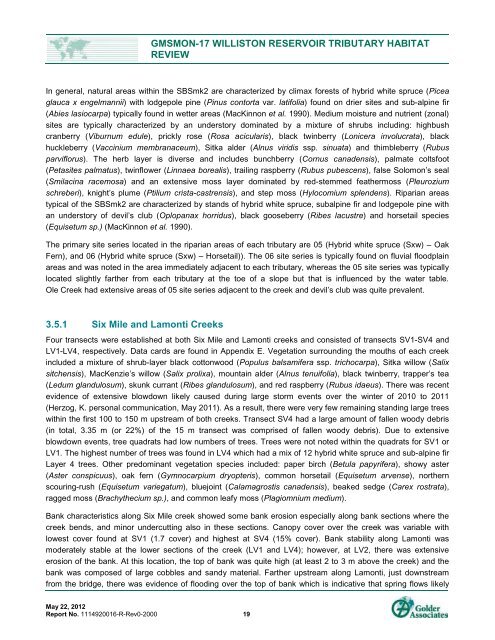GMSMON-17 WILLISTON RESERVOIR TRIBUTARY - BC Hydro
GMSMON-17 WILLISTON RESERVOIR TRIBUTARY - BC Hydro
GMSMON-17 WILLISTON RESERVOIR TRIBUTARY - BC Hydro
You also want an ePaper? Increase the reach of your titles
YUMPU automatically turns print PDFs into web optimized ePapers that Google loves.
May 22, 2012<br />
Report No. 1114920016-R-Rev0-2000 19<br />
<strong>GMSMON</strong>-<strong>17</strong> <strong>WILLISTON</strong> <strong>RESERVOIR</strong> <strong>TRIBUTARY</strong> HABITAT<br />
REVIEW<br />
In general, natural areas within the SBSmk2 are characterized by climax forests of hybrid white spruce (Picea<br />
glauca x engelmannii) with lodgepole pine (Pinus contorta var. latifolia) found on drier sites and sub-alpine fir<br />
(Abies lasiocarpa) typically found in wetter areas (MacKinnon et al. 1990). Medium moisture and nutrient (zonal)<br />
sites are typically characterized by an understory dominated by a mixture of shrubs including: highbush<br />
cranberry (Viburnum edule), prickly rose (Rosa acicularis), black twinberry (Lonicera involucrata), black<br />
huckleberry (Vaccinium membranaceum), Sitka alder (Alnus viridis ssp. sinuata) and thimbleberry (Rubus<br />
parviflorus). The herb layer is diverse and includes bunchberry (Cornus canadensis), palmate coltsfoot<br />
(Petasites palmatus), twinflower (Linnaea borealis), trailing raspberry (Rubus pubescens), false Solomon’s seal<br />
(Smilacina racemosa) and an extensive moss layer dominated by red-stemmed feathermoss (Pleurozium<br />
schreberi), knight’s plume (Ptilium crista-castrensis), and step moss (Hylocomium splendens). Riparian areas<br />
typical of the SBSmk2 are characterized by stands of hybrid white spruce, subalpine fir and lodgepole pine with<br />
an understory of devil’s club (Oplopanax horridus), black gooseberry (Ribes lacustre) and horsetail species<br />
(Equisetum sp.) (MacKinnon et al. 1990).<br />
The primary site series located in the riparian areas of each tributary are 05 (Hybrid white spruce (Sxw) – Oak<br />
Fern), and 06 (Hybrid white spruce (Sxw) – Horsetail)). The 06 site series is typically found on fluvial floodplain<br />
areas and was noted in the area immediately adjacent to each tributary, whereas the 05 site series was typically<br />
located slightly farther from each tributary at the toe of a slope but that is influenced by the water table.<br />
Ole Creek had extensive areas of 05 site series adjacent to the creek and devil’s club was quite prevalent.<br />
3.5.1 Six Mile and Lamonti Creeks<br />
Four transects were established at both Six Mile and Lamonti creeks and consisted of transects SV1-SV4 and<br />
LV1-LV4, respectively. Data cards are found in Appendix E. Vegetation surrounding the mouths of each creek<br />
included a mixture of shrub-layer black cottonwood (Populus balsamifera ssp. trichocarpa), Sitka willow (Salix<br />
sitchensis), MacKenzie’s willow (Salix prolixa), mountain alder (Alnus tenuifolia), black twinberry, trapper’s tea<br />
(Ledum glandulosum), skunk currant (Ribes glandulosum), and red raspberry (Rubus idaeus). There was recent<br />
evidence of extensive blowdown likely caused during large storm events over the winter of 2010 to 2011<br />
(Herzog, K. personal communication, May 2011). As a result, there were very few remaining standing large trees<br />
within the first 100 to 150 m upstream of both creeks. Transect SV4 had a large amount of fallen woody debris<br />
(in total, 3.35 m (or 22%) of the 15 m transect was comprised of fallen woody debris). Due to extensive<br />
blowdown events, tree quadrats had low numbers of trees. Trees were not noted within the quadrats for SV1 or<br />
LV1. The highest number of trees was found in LV4 which had a mix of 12 hybrid white spruce and sub-alpine fir<br />
Layer 4 trees. Other predominant vegetation species included: paper birch (Betula papyrifera), showy aster<br />
(Aster conspicuus), oak fern (Gymnocarpium dryopteris), common horsetail (Equisetum arvense), northern<br />
scouring-rush (Equisetum variegatum), bluejoint (Calamagrostis canadensis), beaked sedge (Carex rostrata),<br />
ragged moss (Brachythecium sp.), and common leafy moss (Plagiomnium medium).<br />
Bank characteristics along Six Mile creek showed some bank erosion especially along bank sections where the<br />
creek bends, and minor undercutting also in these sections. Canopy cover over the creek was variable with<br />
lowest cover found at SV1 (1.7 cover) and highest at SV4 (15% cover). Bank stability along Lamonti was<br />
moderately stable at the lower sections of the creek (LV1 and LV4); however, at LV2, there was extensive<br />
erosion of the bank. At this location, the top of bank was quite high (at least 2 to 3 m above the creek) and the<br />
bank was composed of large cobbles and sandy material. Farther upstream along Lamonti, just downstream<br />
from the bridge, there was evidence of flooding over the top of bank which is indicative that spring flows likely
















